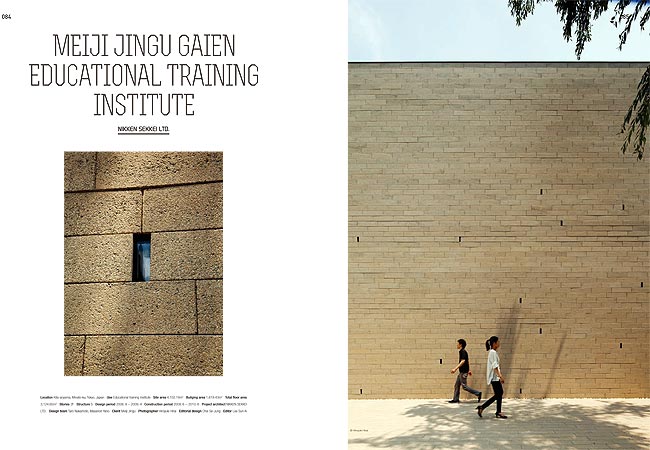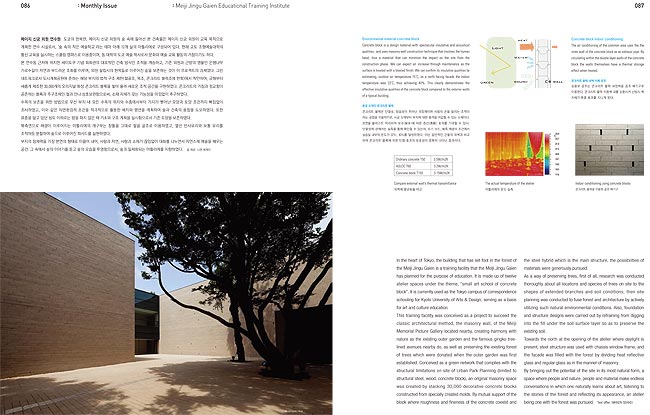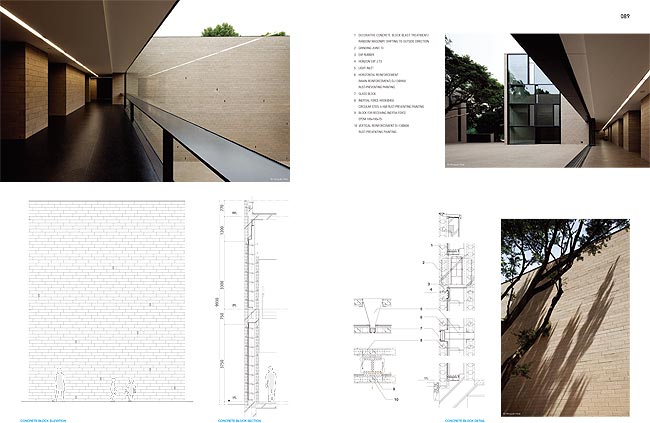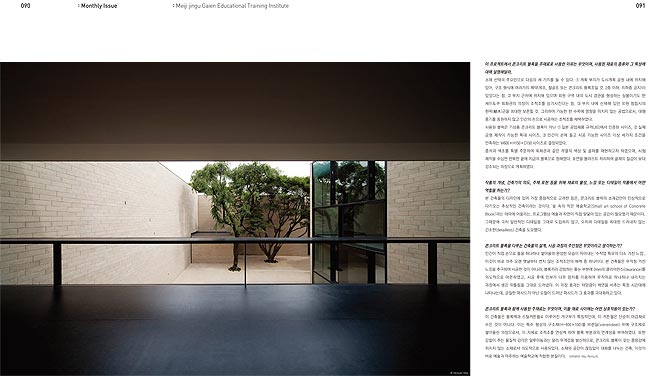Meiji Jingu Gaien Educational Training Institute
NIKKEN SEKKEI LTD.




메이지 신궁 외원 연수원 도쿄의 한복판, 메이지 신궁 외원의 숲 속에 들어선 본 건축물은 메이지 신궁 외원이 교육 목적으로 계획한 연수 시설로서,‘ 숲 속의 작은 예술학교’라는 테마 아래 12개 실의 아틀리에로 구성되어 있다. 현재 교토 조형예술대학의 통신 교육을 실시하는 스쿨링 캠퍼스로 이용중이며, 동 대학의 도쿄 예술 학사로서 문화와 예술 교육 활동의 거점이기도 하다. 본 연수동 근처에 위치한 세이토쿠 기념 회화관의 대표적인 건축 방식인 조적을 계승하고, 기존 외원과 근방의 명물인 은행나무 가로수길이 자연과 부드러운 조화를 이루며, 외원 설립시의 헌목들로 이루어진 숲을 보존하는 것이 이 프로젝트의 과제였다. 그린 네트워크로서 도시계획공원에 준하는 해당 부지의 법적 구조 제한(철골조, 목조, 콘크리트 블럭조에 한함)에서 착안하여, 금형부터 새롭게 제조한 30,000개의 오리지널 화장 콘크리트 블록을 쌓아 올려 새로운 조적 공간을 구현하였다. 콘크리트의 거침과 정교함이 공존하는 블록과 주구조체인 철과 만나 상호보완함으로써, 소재 자체가 갖는 가능성을 아낌없이 추구하였다.
수목의 보존을 위한 방법으로 우선 부지 내 모든 수목의 위치와 수종에서부터 가지가 뻗어난 모양과 토양 조건까지 빠짐없이 조사하였고, 이와 같은 자연환경적 조건을 적극적으로 활용한 배치와 평면을 계획하여 숲과 건축의 융합을 도모하였다. 또한 표층을 덮고 있던 성토 이하로는 땅을 파지 않은 채 기초와 구조 계획을 실시함으로서 기존 토양을 보존하였다. 북측면으로 채광이 이루어지는 아틀리에의 개구부는 창틀을 그대로 철골 골조로 이용하였고, 열선 반사유리와 보통 유리를 조적하듯 분할하여 숲으로 이루어진 파사드를 실현하였다. 부지의 잠재력을 가장 본연의 형태로 이끌어 내어, 사람과 자연, 사람과 소재가 끊임없이 대화를 나누면서 자연스레 예술을 배우는 공간. 그 속에서 숲의 이야기를 듣고 숲의 모습을 투영함으로서, 숲과 일체화되는 아틀리에를 지향하였다.
글 제공: 니켄 세케이
이 프로젝트에서 콘크리트 블록을 주재료로 사용한 이유는 무엇이며, 사용된 재료의 종류와 그 특성에 대해 설명해달라.
소재 선택의 주요인으로 다음의 세 가지를 들 수 있다
① 계획 부지가 도시계획 공원 내에 위치해 있어, 구조 형식에 여러가지 제약(목조, 철골조 또는 콘크리트 블록조일 것. 2층 이하. 지하층 금지)이 있었다는 점.
② 부지 근처에 위치해 있으며 외원 구역 내의 도시 경관을 형성하는 심볼이기도 한 세이토쿠 회화관의 의장이 조적조를 상기시킨다는 점.
③ 부지 내에 산재해 있던 외원 창립시의 헌목(?木)군을 최대한 보존할 것. 그리하여 가능한 한 수목에 영향을 미치지 않는 공법으로서, 대형 중기를 동원하지 않고 인간의 손으로 시공하는 조적조를 채택하였다.
사용된 블럭은 기성품 콘크리트 블록이 아닌 ① 일본 공업제품 규격(JIS)에서 인증된 사이즈, ② 실제 금형 제작이 가능한 특대 사이즈, ③ 인간이 손에 들고 시공 가능한 사이즈 이상 세가지 조건을 만족하는 W600×H150×D150 사이즈로 결정되었다. 종석과 색조를 특별 주문하여 회화관과 같은 계열의 색상 및 골재를 재현하고자 하였으며, 시험 제작을 수십번 반복한 끝에 지금의 블록으로 정해졌다. 표면을 블라스트 처리하여 골재의 질감이 보다 강조되는 의장으로 계획하였다.
작품의 개념, 건축가의 의도, 주제 표현 등을 위해 재료의 물성, 느낌 또는 디테일이 작품에서 어떤 역할을 하는가?
본 건축물의 디자인에 있어 가장 중점적으로 고려한 점은, 콘크리트 블럭의 소재감만이 인상적으로 다가오는 추상적인 건축이라는 것이다‘. 숲 속의 작은 예술학교(Small art school of Concrete Block)’라는 테마에 어울리는, 프로그램상 예술과 자연이 직접 맞닿아 있는 공간이 필요했기 때문이다. 그때문에 극히 일반적인 디테일을 그대로 도입하지 않고, 오히려 디테일을 최대한 드러내지 않는 간소한(detailless) 건축을 도모했다.
콘크리트 블록을 다루는 건축물의 설계, 시공 과정의 주안점은 무엇이라고 생각하는가?
인간이 직접 손으로 돌을 하나하나 쌓아올려 완성한 모습이 자아내는‘ 수작업 특유의 다소 거친 느낌’. 이것이 바로 아주 오랜 옛날부터 변치 않는 조적조만의 매력 중 하나이다. 본 건축물은 무작정 거친 느낌을 추구하여 시공한 것이 아니라, 블록끼리 감합하는 줄눈 부분에 2mm의 클리어런스(clearance)를 의도적으로 마련하였고, 시공 후에 인부가 나무 망치를 이용하여 무작위로 하나하나 내리치는 과정에서 생긴 뒤틀림을 그대로 드러냈다. 이 의장 효과는 태양광이 벽면을 비추는 특정 시간대에 나타나는데, 균질한 파사드가 아닌 요철이 드러난 파사드가 그 효과를 극대화하고 있다.
콘크리트 블록과 함께 사용된 주재료는 무엇이며, 이들 재료 사이에는 어떤 상호작용이 있는가?
이 건축물은 블록벽과 스틸커튼월로 이루어진 개구부가 특징적인데, 이 커튼월은 단순히 마감재로 쓰인 것이 아니다. 이는 특수 형상의 구조재(H-400×100)를 비렌딜(vierendeel) 위에 구조체로 쌓아올린 의장으로서, 이 자체로 조적조를 연상케 하여 블록 부분과의 연계성을 부여하였다. 또한 강철이 주는 물질적 감각은 알루미늄과는 달리 무게감을 발산하므로, 콘크리트 블록이 갖는 중량감에 뒤지지 않는 소재로서 의도적으로 사용되었다. 소재와 공간이 끊임없이 대화를 나누는 건축, 이것이 바로 예술과 마주하는 예술학교에 적합한 본질이다.
인터뷰이: 야노 마사노리
In the heart of Tokyo, the building that has set foot in the forest of the Meiji Jingu Gaien is a training facility that the Meiji Jingu Gaien has planned for the purpose of education. It is made up of twelve atelier spaces under the theme, “small art school of concrete block”. It is currently used as the Tokyo campus of correspondence schooling for Kyoto University of Arts & Design, serving as a basis for art and culture education.
This training facility was conceived as a project to succeed the classic architectural method, the masonry wall, of the Meiji Memorial Picture Gallery located nearby, creating harmony with nature as the existing outer garden and the famous gingko treelined avenues nearby do, as well as preserving the existing forest of trees which were donated when the outer garden was first established. Conceived as a green network that complies with the structural limitations on site of Urban Park Planning (limited to structural steel, wood, concrete block), an original masonry space was created by stacking 30,000 decorative concrete blocks constructed from specially created molds. By mutual support of the block where roughness and fineness of the concrete coexist and the steel hybrid which is the main structure, the possibilities of materials were generously pursued.
As a way of preserving trees, first of all, research was conducted thoroughly about all locations and species of trees on site to the shapes of extended branches and soil conditions; then site planning was conducted to fuse forest and architecture by actively utilizing such natural environmental conditions. Also, foundation and structure designs were carried out by refraining from digging into the fill under the soil surface layer so as to preserve the existing soil.
Towards the north at the opening of the atelier where daylight is present, steel structure was used with chassis window frame, and the facade was filled with the forest by dividing heat reflective glass and regular glass as in the manner of masonry. By bringing out the potential of the site in its most natural form, a space where people and nature, people and material make endless conversations in which one naturally learns about art, listening to the stories of the forest and reflecting its appearance, an atelier being one with the forest was pursued.
Text offer: NIKKEN SEKKEI
Is there any particular reason for using Concrete Block as main material for this project? And what types of material have you used in this project, and what general properties do they have?
There are three main reasons for the selection of materials.
1) The site is on an Urban Park Development, thus have a number of structural limitations (should be wood, steel structure or concrete block. 2 stories or lower. No basement levels)
2) The design of the Meiji Memorial Picture Gallery, which is located near the site and also the symbol of the urban view within outer garden area, reminds one of masonry wall.
3) The existing trees dispersed within the site had to be preserved as much as possible. Thus, the masonry wall that does not involve large machinery but is constructed by the human hand was selected, as a construction method that has a minimal impact on the trees. The blocks used were not the typical concrete blocks but selected as W600×H150×D150 blocks which satisfy the three conditions of size: 1) size certified by the JIS standards, 2) extra large size with which the mold can be manufactured, 3) size constructible with the human hand.
The key stone and color shades are custom-tailored so as to represent the same shades and aggregates as those used for the Picture Gallery, and the present blocks were selected through tens of repetitive mock-up productions. The surface was sandblasted to emphasize the texture of aggregates in the design.
How did the materiality, feeling and details of Concrete Block affect the project in terms of concept, the intention of architect and its presentation?
The main focus of the design of the building, was the abstract architectural quality that solely brings forward the impressive material texture of the concrete block. This came about from the need of a programmatic space where art meets nature directly, and harmonizes with the theme “small art school of concrete block”. Hence, we did not adopt common details, but pursued a detail-less architecture that conceals as much of the detail as possible.
About what should we be careful when designing and undertaking construction with Concrete Block?
“A relatively rough sense of hand craftsmanship” given off by human hands of stacking blocks one by one and completing the construction. This is one of the everlasting appeals of the masonry block. This building is not just constructed to bring out the sense of roughness, but with 2mm clearance set with intention where the block joints meet, revealing as it is the distortions created by the construction worker who strikes each of the blocks randomly after the construction. The effect of this designed surface is more apparent during a specific time of day when the sun hits the facade, which is not even but rugged so as to maximize the effect.
What material was mainly used with Concrete Block in this project, and how do those materials interact with each other?
The characteristic of this building is the use of block wall and curtain wall in the opening. The curtain wall is not solely used as a finish. This design stacks the specially figured structural members (H-400×100) above the vierendeel to remind one of the masonry wall and contribute to the connection with the block parts. Also, as a material to contend with concrete block in the sense of weight, steel was used intentionally whose material sense brings forth weightiness unlike aluminum. An architecture in which endless conversations occur between materials and space. This is the essence suitable for an art school that comes face to face art.
Interviewee: YANO Masanori
건축문화 2016년 10월호 [Monthly Issue]페이지 © 에이엔씨출판(주)